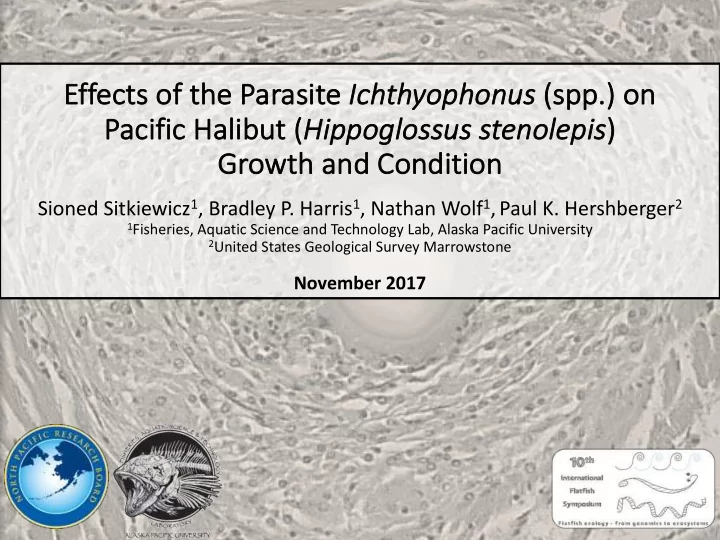

Ef Effects of the Parasite Ich chthyophonus (s (spp.) ) on Pa Pacific Halibut ( Hip Hippog oglos lossus st stenolepis ) ) Gr Growth an and Condit itio ion Sioned Sitkiewicz 1 , Bradley P. Harris 1 , Nathan Wolf 1 , Paul K. Hershberger 2 1 Fisheries, Aquatic Science and Technology Lab, Alaska Pacific University 2 United States Geological Survey Marrowstone November 2017
Ichthyophonus (spp.) • Mesomycetozoea • Schizonts & hyphae www.bioone.org • First described in 1893 • Reported in 145 fish species • Globally distributed • Linked to mass mortalities & epizootics [Rahimian and Thulin 1996; Kocan et al. 2004; Hershberger et al. 2002]
Host signs • “Ichthyophoniasis” • Infection routes debated • Physical & physiological effects • General prevalence increase with host age and size [Hershberger et al. 2002; Kramer-Schadt et al. 2010]
Ichthyophonus in Alaska (AK), United States ALASKA [Olson 1986; Gregg et al. 2014; Kocal et al. 2004; Kocan et al. 2009; Marty et al. 2004; F.A.S.T. Lab Unpublished Data]
Study subject/host species • Pacific halibut ( Hippoglossus stenolepis )
Research objectives 1. Explore Ichthyophonus trends in AK P. halibut from 2011-2017 2. Assess physiological effects of parasite using condition analyses
Methods – study site “ Post-mortem, pre-dumpster ” www.alaska.net
Methods IMPEDANCE (Z) Bioelectrical Impedance Analysis Resistance (R) PHASE ANGLE Z R = poorer condition
Methods
Methods • Parasite detection via tissue explant culture • Tissue examined after 7 and 14 days
Results
Results • General linear models (binomial) Culture (+/- Ich) ~ Year + Sex + Length + Age + Length*Sex + Gape Ichthyophonus Prevalence in P. Halibut from Homer, AK from 2011-2017 100% 90% 80% 70% Prevalence 60% 50% 40% 30% 20% 10% 0% 2011 2012 2013 2016 2017 Year
Results – he hear art we weigh ght Heart vs. Whole Weights in Infected and Non-infected P. Halibut 30 25 20 Heart Weight (g) 15 Infected Non-infected 10 5 0 0 5 10 15 20 25 30 35 Whole Weight (kg)
Results – phas phase angl angle • GLM indicated culture was not a significant predictor of phase angle • No relationship between Fulton’s K and infection status either Phase Angles of Infected vs. Non-infected P. Halibut 30 28 26 Phase angle (degrees) 24 22 20 18 16 14 12 10 0 1 Infection status
Conclusions • Ichthyophonus prevalence ranged from 19-59% • Highest levels in most recent years • Ichthyophonus may cause subclinical infections in P. halibut Next steps: • BIA-based body composition model • Additional condition analyses
Acknowledgements • Dr. Nathan Wolf, APU • Dr. Paul Hershberger, USGS • Dr. Bradley Harris, APU • Sheyna Wisdom, FWS • USGS Marrowstone Lab • Washington Disease & Diagnostics Lab (WADDL) • Western Fisheries Research Center (WFRC) • APU student & staff research support
Questions?
Recommend
More recommend